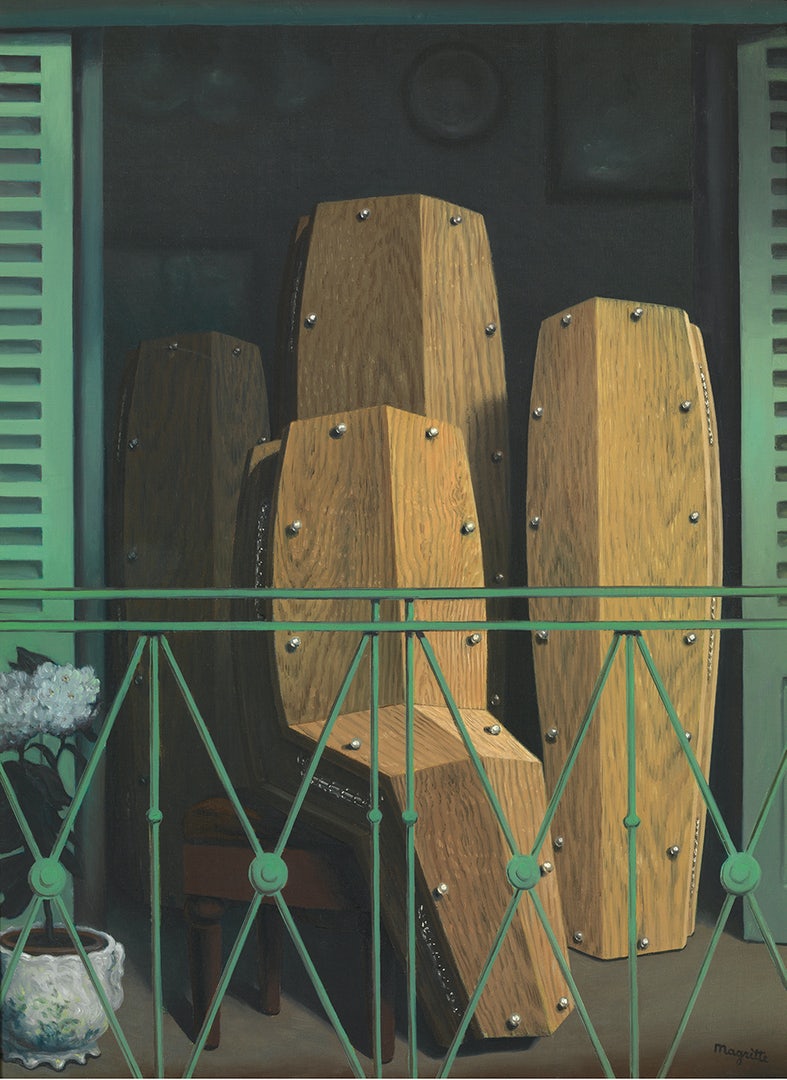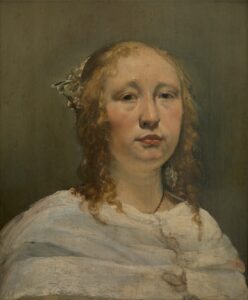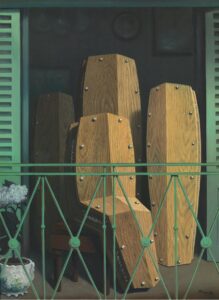
René Magritte: Perspective II, Manet’s Balcony, 1950
Sam Vangheluwe

(fragment)
A long while ago, as a student at the Antwerp Academy of Fine Arts, I would step out into the street on a Sunday morning and be overcome by silence. As if the whole city was still asleep, or lazing over breakfast. Very few cars about. Starlings chirping. Peace and quiet.
From time to time, to avoid the onset of the urban bustle, I headed for the Museum of Fine Arts, treading lightly so as not to wake my fellow citizens. Its doors were duly open (as were those of churches at that time, but with fewer devotees about). Bought me a ticket from a tiny box office in a corner of the pronaos, climbed the monumental marble staircase, and without design, entered whichever deserted hall took my fancy. For hours, seemingly, one could wander around without encountering a soul. Accompanied only by the silent song of painting. And every painting and sculpture was in its place, always. Ah, those were the days. Should a pandemic have broken out then, the Museum would have been the safest haven. A question of social distancing.
Very undemocratic, all that, downright elitist. Reactionary, no doubt.
In this brave new world, museums and exhibitions are inclusive, democratized, immersive, 3D, digitized; they are educational theme parks, family-friendly entertainment centers, nocturnal recreation, practical jokery, merchandise distribution hubs, the Greatest Show on Earth with bells and whistles. It takes a virulent pandemic to empty a fine arts museum these days.
By way of exception, the Antwerp Museum of Fine Arts has been closed for renovation since 2011. An intriguing fact: to date, no popular uprising has occurred.
Luckily we also have a Museum of Fine Arts in the pleasant city of Ghent. Although of a somewhat later date, it too was conceived in neo-classical style (as are most national and municipal museums of the Napoleonic legacy): a lofty temple of the arts, symmetrical, high-ceilinged, with zenithal light filtering through vast skylights. Ample seating upholstered with green velvet.
When I last visited the Ghent Museum following a previous renovation (2003-2007), I was full of joy and praise. The museum exuded a rare serenity, favourable to calm contemplation, with little to distract attention. I was so gratified that, in my soft-heartedness, I overlooked certain shortcomings. These have now come to the fore.
Recently, the Ghent Museum has undergone another refurbishment. It now displays its proper collection, spread over 40 halls, thematically and sometimes monographically ordered. As a rule I dislike thematic exhibitions. Ever since the pandemic, museum directors and curators must be secretly rejoicing: no visitor can escape the course as laid out by them. No more wandering. No escaping the thematic order.
Previously, the colour scheme throughout was subdued, unobtrusive. This has now been abandoned. One wonders if curators these days are at all aware that paintings interact with their background. You cannot with impunity hang any painting on a yellow, bright blue, or emerald green wall. It is deplorable. Once again, painting is sacrificed in favor of a theme. I am loath to forgive whoever came up with this abomination. Yet, my fondness for this institution inspiring self-restraint, I tell myself that walls can be repainted.
Concerning the lighting, I am uncertain. I suspect the prevailing curatorial heliophobia. Many of the skylights were covered – but possibly temporarily. Indeed, there was some noisy work being done on certain parts of the roof. Perhaps the curators will see the error of their polychromatic walls, once the paintings are again naturally lighted.
Not new but irksome as ever is the interstitial positioning of pieces of ‘contemporary’ art. These hardly ever ‘enter into dialogue’, as the curators would have it, but demand full attention by their mere bulk. As you take a few steps back in order to see a painting from the pertinent distance, you trip over them. Conversely, I have never before seen paintings of the Flemish Primitives, for example, interspersed among the exhibits in a museum of contemporary art (although I would not put it past them). The supposed dialogue is unilateral, apparently.

During my previous visit, I could not help noticing an emphasis, particularly in the arts of the 18th and 19th centuries, on what can only be called ‘bourgeois’ art – conservative, conventional, fashionable genre art. ‘Neo-medieval’ painting, for example – too insipid to irritate. I wonder why this is. Why are the modernists not firmly put to the fore? Is this the ‘old’ museum forfeiting its artistic relevance in favour of the SMAK (Municipal Museum of Contemporary Art), just a stone’s throw away? After all, collections of contemporary art do not resort to thematic ordering (or do they?). A grave problem with the thematic approach is this: when the museum elects to “confront innovative with conservative artists,” invites us “to contemplate the image of woman, the relation between city and country, through the ages,” et tutti quanti, a perilous process is set in motion. Paintings are then no longer appreciated for their inherent painterly or artistic value, but are rounded up as mere educational materials. Pretty illustrations in a textbook that was written by whoever conceived the theme. Indeed, short texts accompany many of the works at eye level for the benefit (or to the detriment) of the young visitor (“The boy steps into the water. There are little fishes in the water…”). The museum seems determined to socialise children into reading text instead of looking at paintings (yes, museums win awards for this kind of ‘public outreach’).
The many masterpieces that the Museum possesses, deserve better. A tiny selection of the range: Hieronymus Bosch (the enchanting Christ Carrying the Cross), Van Eyck, Patinir, Pourbus (the delightful Portrait of a Young Lady), Tintoretto, Rubens (The Flagellation of Christ), Van Dyck, Jordaens, Géricault, Daumier, Corot, Rouault. And when will the Anglo-Saxon world finally discover the modern painters from our neck of the woods: the magic of James Ensor, the vigour of Jean Brusselmans, the master of black and white Frans Masereel, the forceful Constant Permeke, and the in equal measure intense and sensitive Gustave De Smet. De Smet’s Head of a Child (1916), could easily fill an entire museum hall by its lonely self.
There are many great painters. And there are too many others who fabricate images, fit only for thematic scrapbooks. In and by themselves, these masterpieces warrant more than one visit to the Ghent Museum of Fine Arts. And here’s to hoping that the curators of the Antwerp Museum of Fine Arts will dare to let their treasures sing for themselves.
Volume 36 no 1 September / October 2021

